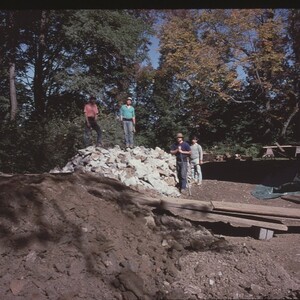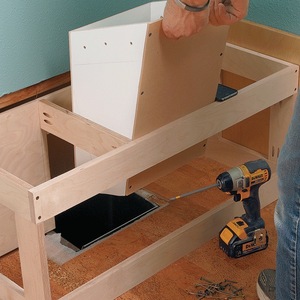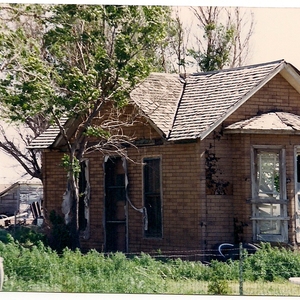Hi there, I’m a carpenter who’s finally building a house for himeself. I’ve convinced myself that I want a curved roof on my house and am trying to design the simplest framing method to achieve this goal. I vaugely remember an article from a few years ago about a guy who used I-joists running longitudinally along the curve so that the only curved cuts he made were on his end bearing walls. Does anyone remember this article or have any other strategies I should consider?
-Scott


















Replies
First, your question begs the question, why complicate matters? Are you talking about a Barrel vault dormer or a a curve cut in a rafter? There was an excellent article on barrel vaults in FHB bout two years ago. I don't know how to find it , though I'm sure someone else here can direct you.
No dormers, just one long rectangular house (30x60) covered by a single curving roof form (like a shed roof only not straight). It's actually going to be a passive solar house with the tall side oriented to the south, and the roof form will help to bring light (&heat) into the space, so it's not a totally random idea.
So this is an elevated quonset hut shape? A half cylinder laying down rather than round walls with a conical roof.
Seems to me that your 60' long joists would be so massive they would take up the room you are trying to gain. You will really need some sort of trusses for this long shape or interupt with posts or load bearing walls.
It mioght be that steel building people could do the trusses though to define your shape..
Welcome to the
Taunton University of Knowledge
FHB Campus at Breaktime.
where
Excellence is its own reward!
I have a bunkie at my cottage property that has the shape you are planning, am I correct to assume the arc follows the 60' length, with the 30' length facing the sun. Mine looks great but plenty of fussy parts. FHB had a workshop/studio featured in a magazine a few years ago, copper clad with windows at floor level.
Any ways, the building department gave me a bit of a hassle. The difficult part of framing the roof was ensuring the roof joists sit vertically above the wall joists while the top-plate of the wall arc down to the rear of the building. Also the top plate had to be scored to facilitate the 62' radius of my roof. Autocad was essential since all of the studs had to be cut to exact lenghts to create the proper radius.
Before you commit to the arc thinkabout the fascia and soffits, pain in the butt.
Good luck!!!
By the way mine is still incomplete after 2 years, very part time builder.
I do remember seeing that article. Have you looked in the Magazine Index on the FHB home page? Fourth button in the top row of buttons at the top of the window.
The first thought that occurs to me is open web wood trusses across the 30' dimension. Depending on the radius you're considering, it might be possible to make a truss by bending the top chord instead of sawing it curved. And spanning the width instead of the length will simplify a lot of things.
Spanning the 30' direction with standard trusses and then building knee walls on top of the trusses is another possibility. Use bridging or blocking to keep the knee wals from folding over on the trusses.
Still another possibility would be a self supporting concrete vault like the domes cloud hidden builds. No framing at all is very simple.
Thanks for the mention dunc. I was just gonna wonder if there was another way to make a vault.....the method's slipping my mind...oh yeah, concrete!
Here's a JLC article talking about framing vaults. Didn't read it, so don't know if it answers the original question. http://www.findarticles.com/cf_dls/m0NSZ/3_21/95527700/p2/article.jhtml?term=
I have seen an article on something similar. Issue #27 p.26-31. They use concrete pillars and curved trusses in a post and beam style. The trusses look like glu-lams. I hope that helps a little.
Are you mostly going for looks on the outside, inside or both. If you just want the look for the inside, there are a lot of other options. FlexC Track for example.
Scott,I'm just finishing up an addition on my own house.While in the design stage the 2002FHB houses arrived,had a pic of a music room with a barrel vaulted cieling.I JUST HAD TO HAVE ONE.I went to a local truss shop and disscused it with the designer.We came up with a scissor truss......replaced the 2x4 bottom chord with a 2x12 made the interior slope so when I cut the arc in it it still had at least 31/2"of width so the design for a 2x4 bottem chord was still strong enough.when they arrived I cut the arcs with a circular saw(arc was shallow enough to do so).The truss guy showed me a truss in his lot that they had done the same thing on the top chord.You might be able to do both.Go see a truss shop with a design computer.Question I have is if you do the outside ...how would you roof it? SGB
I did a couple of curved roofs on a place a few years back, one room was 30' wide, one was 20' wide.
We used trusses. The upper chord was 2x8, lower chord 2x6, overplated for the design criteria, I think we spec'd it at 30# live, 20# dead.
The truss design is (at least locally) called a bowstring truss. The lower chord is like any other, the upper chord is segmented into an arc. The upper surface of the joints can be sanded with a belt sander to create a pleasing radius. (We checked with the enginer, it was part of the design).
Sheathe with 2x6 T&G.
Lay some sleepers down 16" OC perpindicular to the truss run, install rigid foam,cover with 1/2" CDX, it conforms well.
Fabral makes a metal roof that is designed for just such a situation.
On the underside, the open trusses with the T&G is quite nice. Add a few skylights, a little LV lighting, and you get a pleasant, graceful, if somewhat rustic or industrial interior.
Just one way to see it.
DRC
did the same exact thing on a house.
trusses are the way to go.
you can even make them on sight, providing time and room.
probably save yourself some $$$$
and still have a good product.
september 2000, issue #133 "Arch Top In The Valley" pp. 86-91.
- greg
There are many different types of traditional curved roofs in Québec. Originally, the curved section between the porch eaves and the lower section of a gambrel was designed to create swirling air currents so snow would accumulate deeply right there, to provide extra insulation.
These roofs are framed with either trusses or rafters, but the curve is cut in what's called a Coyau (I don't know it's name in English, sorry). This is a piece of 2x that is cut to the curve on one edge, and it bridges from one set of rafters to the other. You can see it in the pic attached. Originally, 1x4 or x6 T&G was nailed on; now we use half-inch ply, but we kerf the interior face 1/8" deep to help bend it.
Nail guns help a lot when you're trying to nail down that roof sheathing and bend it at the same time....
Dinosaur
'Y-a-tu de la justice dans ce maudit monde?
I've designed half round trusses before - Kinda like what "cutter" described.
We built the trusses in short segments of 2X12. Then we hauled them to a wood shop who set up a jig to cut the radius.
It really isn't a big deal if you find someone who's willing to work with you a bit. If someone gives you a bunch of crap at one truss place, try another. Some designers don't want to deal with anything out of the ordinary.
Politics is supposed to be the second oldest profession. I have come to realize that it bears a very close resemblance to the first.